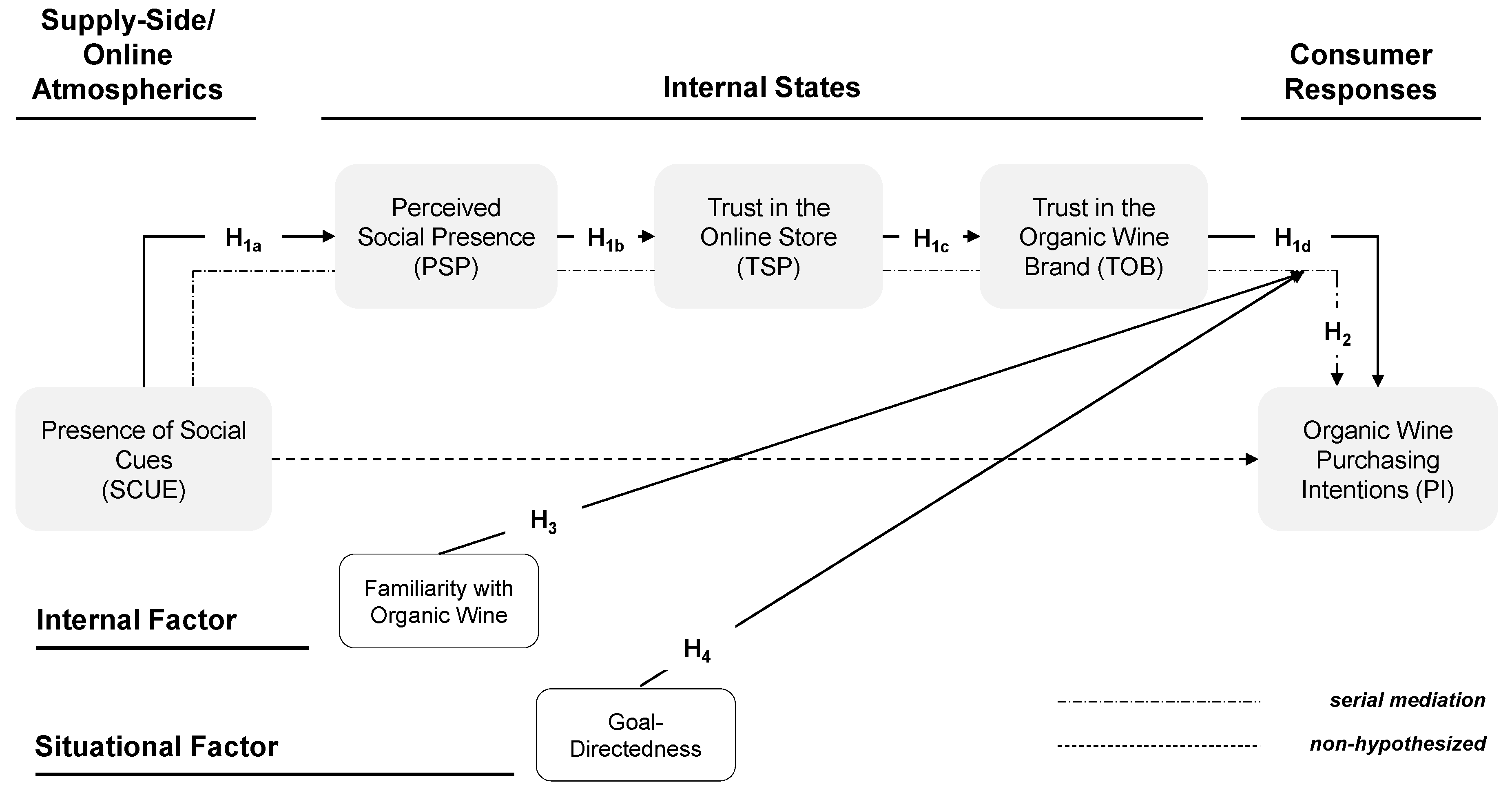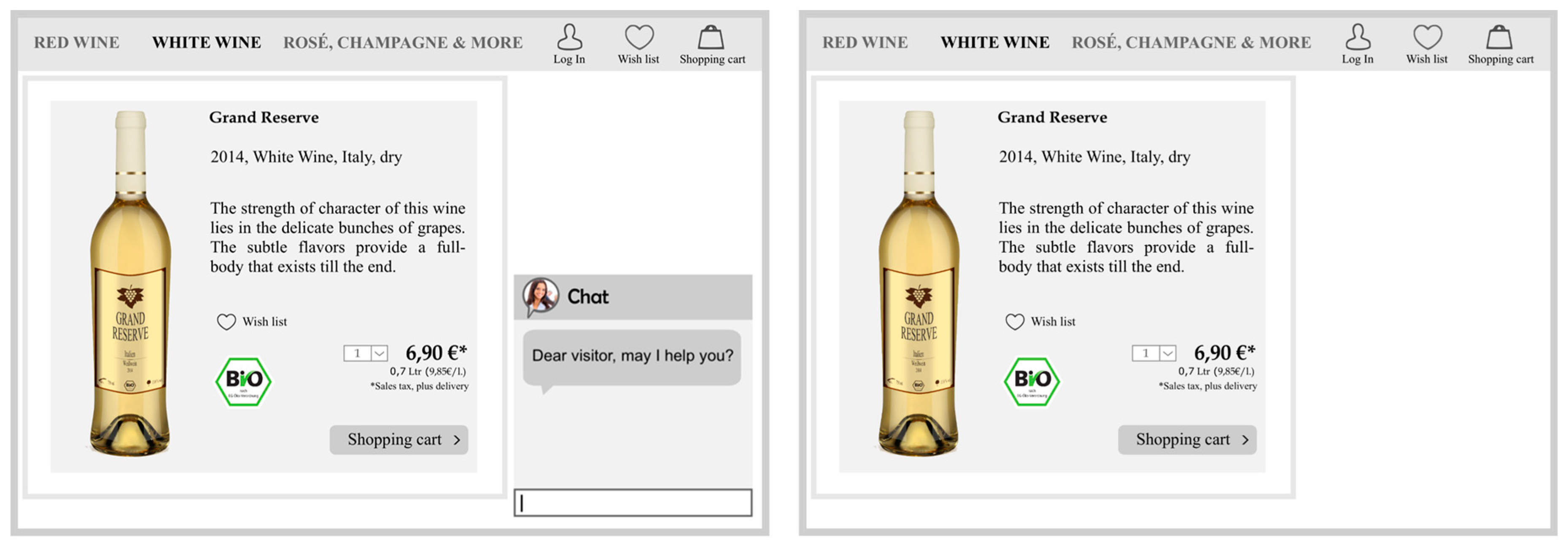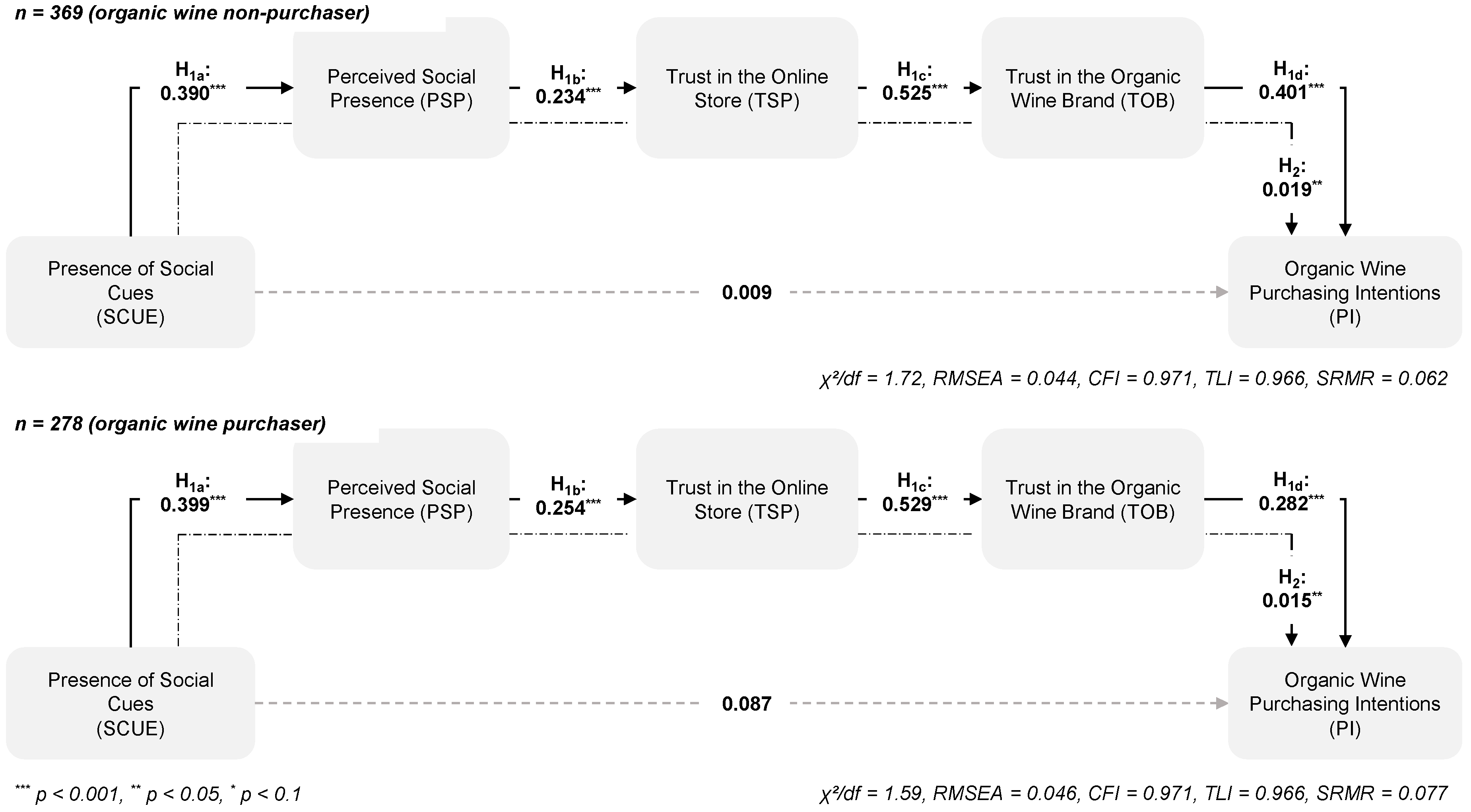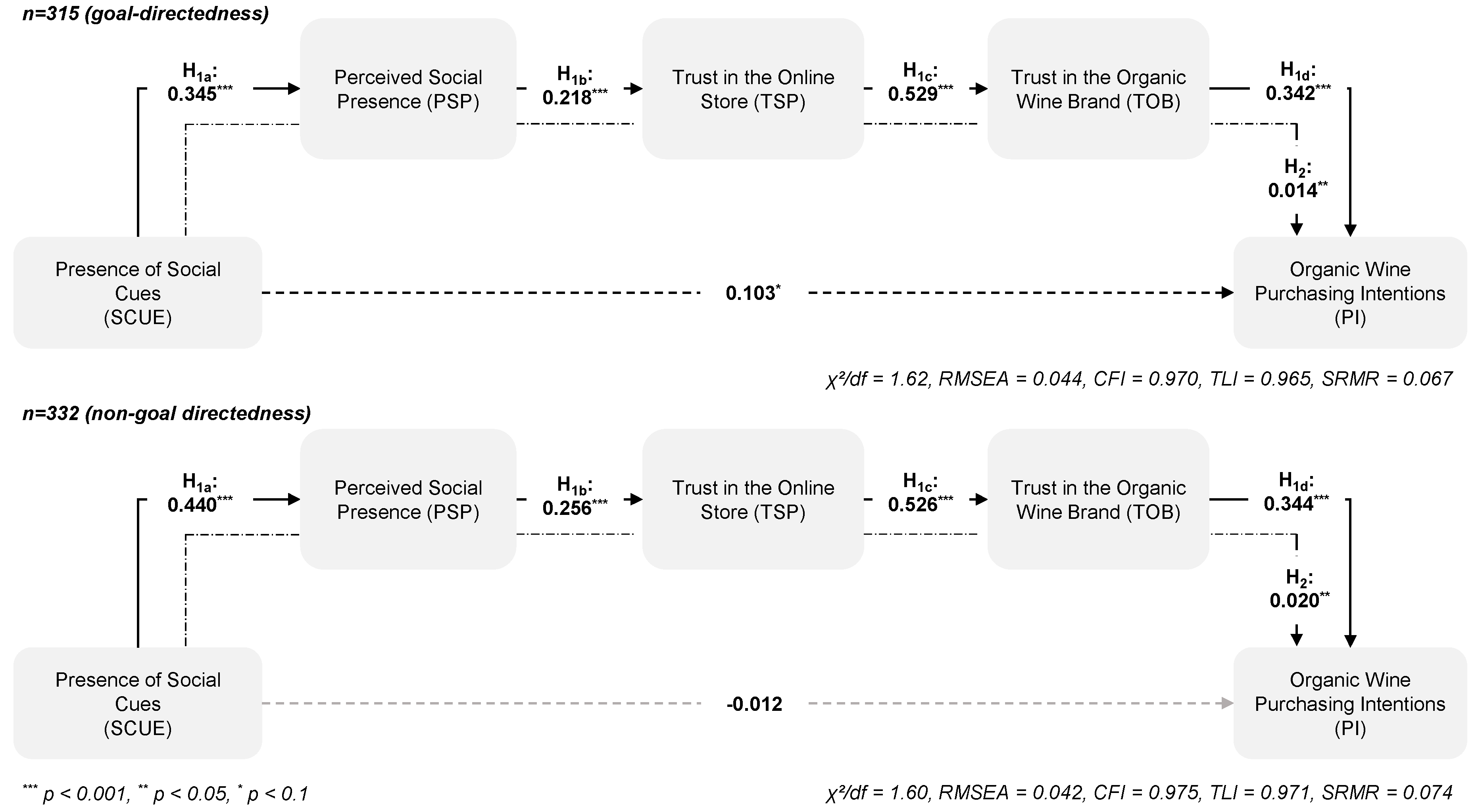Social Cues and the Online Purchase Intentions of Organic Wine
Abstract
1. Introduction
2. Literature Review
3. Conceptual Model and Hypotheses Development
4. Methods
5. Results and Discussion
6. Conclusions
Author Contributions
Funding
Acknowledgments
Conflicts of Interest
References
- OIV. The International Organisation of Vine and Wine. Available online: http://www.oiv.int/en/statistiques/ (accessed on 23 January 2020).
- Rannekleiv, S.; Castroviejo, M. Wine Quarterly Q1 2019. Available online: https://services.rabobank.com/publicationservice/download/publication/token/kcnjuxccJPBXeFVxlSlw (accessed on 18 December 2019).
- Cohen, G. Organic Wine Forecasted to Reach 87.5 m Cases Globally by 2022: European Markets Drive Demand and Growth. Available online: https://www.theiwsr.com/wp-content/uploads/Press-Release-IWSR-Sees-Growth-in-Global-Organic-Wine-Market_9Apr19.pdf (accessed on 22 January 2020).
- Lockshin, L.; Corsi, A.M. Consumer behaviour for wine 2.0: A review since 2003 and future directions. Wine Econ. Policy 2012, 1, 2–23. [Google Scholar] [CrossRef]
- Quinton, S.; Harridge-March, S. Trust and online wine purchasing: Insights into UK consumer behaviour. Int. J. Wine Bus. Res. 2008, 20, 68–85. [Google Scholar] [CrossRef]
- Wiedmann, K.-P.; Hennigs, N.; Henrik Behrens, S.; Klarmann, C. Tasting green: An experimental design for investigating consumer perception of organic wine. Br. Food J. 2014, 116, 197–211. [Google Scholar] [CrossRef]
- Woodworth, R.S. Psychology, A Study of Mental Life; Henry Holt and Co: New York, NY, USA, 1921. [Google Scholar]
- Turley, L.W.; Milliman, R.E. Atmospheric effects on shopping behavior. J. Bus. Res. 2000, 49, 193–211. [Google Scholar] [CrossRef]
- Eroglu, S.A.; Machleit, K.A.; Davis, L.M. Empirical testing of a model of online store atmospherics and shopper responses. Psychol. Mark. 2003, 20, 139–150. [Google Scholar] [CrossRef]
- Cho, M.; Bonn, M.A.; Kang, S. Wine attributes, perceived risk and online wine repurchase intention: The cross-level interaction effects of website quality. Int. J. Hosp. Manag. 2014, 43, 108–120. [Google Scholar] [CrossRef]
- Wang, L.C.; Baker, J.; Wagner, J.A.; Wakefield, K. Can a retail web site be social? J. Mark. 2007, 71, 143–157. [Google Scholar] [CrossRef]
- White, K.; Habib, R.; Hardisty, D.J. How to SHIFT consumer behaviors to be more sustainable: A literature review and guiding framework. J. Mark. 2019, 83, 22–49. [Google Scholar] [CrossRef]
- Abrahamse, W.; Steg, L. Social influence approaches to encourage resource conservation: A meta-analysis. Glob. Environ. Chang. 2013, 23, 1773–1785. [Google Scholar] [CrossRef]
- Gefen, D.; Straub, D.W. Consumer trust in B2C e-Commerce and the importance of social presence: Experiments in e-Products and e-Services. Omega 2004, 32, 407–424. [Google Scholar] [CrossRef]
- Stewart, K.J. Trust transfer on the world wide web. Organ. Sci. 2003, 14, 5–17. [Google Scholar] [CrossRef]
- Schäufele, I.; Hamm, U. Organic wine purchase behaviour in Germany: Exploring the attitude-behaviour-gap with data from a household panel. Food Qual. Prefer. 2018, 63, 1–11. [Google Scholar] [CrossRef]
- van Doorn, J.; Verhoef, P.C. Drivers of and barriers to organic purchase behavior. J. Retail. 2015, 91, 436–450. [Google Scholar] [CrossRef]
- Liobikienė, G.; Bernatonienė, J. Why determinants of green purchase cannot be treated equally? The case of green cosmetics: Literature review. J. Clean. Prod. 2017, 162, 109–120. [Google Scholar] [CrossRef]
- Mann, S.; Ferjani, A.; Reissig, L. What matters to consumers of organic wine? Br. Food J. 2012, 114, 272–284. [Google Scholar] [CrossRef]
- D’Amico, M.; Di Vita, G.; Monaco, L. Exploring environmental consciousness and consumer preferences for organic wines without sulfites. J. Clean. Prod. 2016, 120, 64–71. [Google Scholar] [CrossRef]
- Brugarolas, M.; Martinez-Carrasco, L.; Bernabeu, R.; Martinez-Poveda, A. A contingent valuation analysis to determine profitability of establishing local organic wine markets in Spain. Renew. Agric. Food Syst. 2010, 25, 35–44. [Google Scholar] [CrossRef]
- Bernabéu, R.; Brugarolas, M.; Martínez-Carrasco, L.; Díaz, M. Wine origin and organic elaboration, differentiating strategies in traditional producing countries. Br. Food J. 2008, 110, 174–188. [Google Scholar] [CrossRef]
- Di Vita, G.; Pappalardo, G.; Chinnici, G.; La Via, G.; D’Amico, M. Not everything has been still explored: Further thoughts on additional price for the organic wine. J. Clean. Prod. 2019, 231, 520–528. [Google Scholar] [CrossRef]
- Rahman, I.; Stumpf, T.; Reynolds, D. A comparison of the influence of purchaser attitudes and product attributes on organic wine preferences. Cornell Hosp. Q. 2014, 55, 127–134. [Google Scholar] [CrossRef]
- Bruwer, J.; Saliba, A.; Miller, B. Consumer behaviour and sensory preference differences: Implications for wine product marketing. J. Consum. Mark. 2011, 28, 5–18. [Google Scholar] [CrossRef]
- Brunner, T.A.; Siegrist, M. Lifestyle determinants of wine consumption and spending on wine. Int. J. Wine Bus. Res 2011, 23, 210–220. [Google Scholar] [CrossRef]
- Forbes, S.L. The influence of gender on wine purchasing and consumption. Int. J. Wine Bus. Res. 2012, 24, 146–159. [Google Scholar] [CrossRef]
- Vigar-Ellis, D.; Pitt, L.; Caruana, A. Knowledge effects on the exploratory acquisition of wine. Int. J. Wine Bus. Res. 2015, 27, 84–102. [Google Scholar] [CrossRef]
- Agnoli, L.; Capitello, R.; Begalli, D. Behind intention and behaviour: Factors influencing wine consumption in a novice market. Br. Food J. 2016, 118, 660–678. [Google Scholar] [CrossRef]
- Yang, Y.; Paladino, A. The case of wine: Understanding Chinese gift-giving behavior. Mark. Lett. 2015, 26, 335–361. [Google Scholar] [CrossRef]
- Dobele, A.R.; Greenacre, L.; Fry, J. The impact of purchase goal on wine purchase decisions. Int. J. Wine Bus. Res. 2018, 30, 19–41. [Google Scholar] [CrossRef]
- Bressolles, G.; Durrieu, F. A typology of online buyers for French wine web sites based on electronic service quality dimensions. Int. J. Wine Bus. Res. 2010, 22, 335–348. [Google Scholar] [CrossRef]
- Bonn, M.A.; Kim, W.G.; Kang, S.; Cho, M. Purchasing wine online: The effects of social influence, perceived usefulness, perceived ease of use, and wine involvement. J. Hosp. Mark. Manag. 2016, 25, 841–869. [Google Scholar] [CrossRef]
- Pucci, T.; Casprini, E.; Nosi, C.; Zanni, L. Does social media usage affect online purchasing intention for wine? The moderating role of subjective and objective knowledge. Br. Food J. 2019, 121, 275–288. [Google Scholar] [CrossRef]
- Lynch, J.G.; Ariely, D. Wine online: Search costs affect competition on price, quality, and distribution. Mark. Sci. 2000, 19, 83–103. [Google Scholar] [CrossRef]
- Wells, J.D.; Valacich, J.S.; Hess, T.J. What signal are you sending? How website quality influences perceptions of product quality and purchase intentions. MIS Q. 2011, 35, 373. [Google Scholar] [CrossRef]
- Wang, Y.D.; Emurian, H.H. An overview of online trust: Concepts, elements, and implications. Comput. Hum. Behav. 2005, 21, 105–125. [Google Scholar] [CrossRef]
- Biocca, F.; Harms, C.; Burgoon, J.K. Toward a more robust theory and measure of social presence: Review and suggested criteria. Presence Teleop. Virt. Environ. 2003, 12, 456–480. [Google Scholar] [CrossRef]
- Ogonowski, A.; Montandon, A.; Botha, E.; Reyneke, M. Should new online stores invest in social presence elements? The effect of social presence on initial trust formation. J. Retail. Consum. Serv. 2014, 21, 482–491. [Google Scholar] [CrossRef]
- Lu, B.; Fan, W.; Zhou, M. Social presence, trust, and social commerce purchase intention: An empirical research. Comput. Hum. Behav. 2016, 56, 225–237. [Google Scholar] [CrossRef]
- Oh, C.S.; Bailenson, J.N.; Welch, G.F. A systematic review of social presence: Definition, antecedents, and implications. Front. Robot. AI 2018, 5, 483. [Google Scholar] [CrossRef]
- Jiang, C.; Rashid, R.M.; Wang, J. Investigating the role of social presence dimensions and information support on consumers’ trust and shopping intentions. J. Retail. Consum. Serv. 2019, 51, 263–270. [Google Scholar] [CrossRef]
- Fang, J.; Chen, L.; Wen, C.; Prybutok, V.R. Co-viewing experience in video websites: The effect of social presence on E-Loyalty. Int. J. Electron. Comm. 2018, 22, 446–476. [Google Scholar] [CrossRef]
- Latané, B. The psychology of social impact. Am. Psychol. 1981, 36, 343–356. [Google Scholar] [CrossRef]
- Chen, Y.-S.; Chang, C.-H. Enhance green purchase intentions. Manag. Decis. 2012, 50, 502–520. [Google Scholar] [CrossRef]
- Chen, M.; Wang, Y.; Yin, S.; Hu, W.; Han, F. Chinese consumer trust and preferences for organic labels from different regions. Br. Food J. 2019, 121, 1521–1535. [Google Scholar] [CrossRef]
- van der Heijden, H.; Verhagen, T.; Creemers, M. Understanding online purchase intentions: Contributions from technology and trust perspectives. Eur. J. Inf. Syst. 2003, 12, 41–48. [Google Scholar] [CrossRef]
- Chaudhuri, A.; Holbrook, M.B. The chain of effects from brand trust and brand affect to brand performance: The role of brand loyalty. J. Mark. 2001, 65, 81–93. [Google Scholar] [CrossRef]
- Belanche, D.; Casaló, L.V.; Flavián, C.; Schepers, J. Trust transfer in the continued usage of public e-services. Inf. Manag. 2014, 51, 627–640. [Google Scholar] [CrossRef]
- Sharma, A. The persuasive effect of salesperson credibility: Conceptual and empirical examination. J. Pers. Sell. Sales Manag. 1990, 10, 71–80. [Google Scholar] [CrossRef]
- Xiao, L.; Zhang, Y.; Fu, B. Exploring the moderators and causal process of trust transfer in online-to-offline commerce. J. Bus. Res. 2019, 98, 214–226. [Google Scholar] [CrossRef]
- Goh, S.K.; Balaji, M.S. Linking green skepticism to green purchase behavior. J. Clean. Prod. 2016, 131, 629–638. [Google Scholar] [CrossRef]
- Hong, J.; Sternthal, B. The effects of consumer prior knowledge and processing strategies on judgments. J. Mark. Res. 2010, 47, 301–311. [Google Scholar] [CrossRef]
- Hoffman, D.L.; Novak, T.P. Marketing in hypermedia computer-mediated environments: Conceptual foundations. J. Mark. 1996, 60, 50–68. [Google Scholar] [CrossRef]
- Schlosser, A.E. Experiencing products in the virtual world: The role of goal and imagery in influencing attitudes versus purchase intentions. J. Consum. Res. 2003, 30, 184–198. [Google Scholar] [CrossRef]
- Splendid Research. Studie: Wie Gerne Und Wie Häufig Trinken Die Deutschen Wein? Available online: https://www.splendid-research.com/de/studie-wein.html (accessed on 8 January 2020).
- Pancer, E.; McShane, L.; Noseworthy, T.J. Isolated environmental cues and product efficacy penalties: The color green and eco-labels. J. Bus. Eth. 2017, 143, 159–177. [Google Scholar] [CrossRef]
- Dahl, D.W.; Manchanda, R.V.; Argo, J.J. Embarrassment in consumer purchase: The roles of social presence and purchase familiarity. J. Consum. Res. 2001, 28, 473–481. [Google Scholar] [CrossRef]
- Kaltcheva, V.D.; Weitz, B.A. When should a retailer create an exciting store environment? J. Mark. 2006, 70, 107–118. [Google Scholar] [CrossRef]
- Poddar, A.; Donthu, N.; Wei, Y. Web site customer orientations, Web site quality, and purchase intentions: The role of Web site personality. J. Bus. Res. 2009, 62, 441–450. [Google Scholar] [CrossRef]
- Dodds, W.B.; Monroe, K.B.; Grewal, D. Effects of price, brand, and store information on buyers’ product evaluations. J. Mark. Res. 1991, 28, 307. [Google Scholar] [CrossRef]
- van Doorn, J.; Verhoef, P.C. Willingness to pay for organic products: Differences between virtue and vice foods. Int. J. Res. Mark. 2011, 28, 167–180. [Google Scholar] [CrossRef]
- Lynch, J.G. Theory and external validity. J. Acad. Mark. Sci. 1999, 27, 367–376. [Google Scholar] [CrossRef]
- Walczuch, R.; Lundgren, H. Psychological antecedents of institution-based consumer trust in e-retailing. Inf. Manag. 2004, 42, 159–177. [Google Scholar] [CrossRef]
- Atkinson, L.; Rosenthal, S. Signaling the green sell: The influence of eco-label dource, argument specificity, and product involvement on Consumer Trust. J. Adv. 2014, 43, 33–45. [Google Scholar] [CrossRef]
- Muthén, L.K.; Muthén, B.O. Mplus User’s Guide, 7th ed.; Muthén & Muthén: Los Angeles, CA, USA, 2012. [Google Scholar]
- Bagozzi, R.P.; Yi, Y. Specification, evaluation, and interpretation of structural equation models. J. Acad. Mark. Sci. 2012, 40, 8–34. [Google Scholar] [CrossRef]
- Fornell, C.; Larcker, D.F. Structural equation models with unobservable variables and measurement error: Algebra and statistics. J. Mark. Res. 1981, 18, 382. [Google Scholar] [CrossRef]
- Hu, L.-T.; Bentler, P.M. Cutoff criteria for fit indexes in covariance structure analysis: Conventional criteria versus new alternatives. Struct. Equ. Model. A Multidiscip. J. 1999, 6, 1–55. [Google Scholar] [CrossRef]
- Romano, M.; Chandra, M.; Harutyunyan, M.; Savian, T.; Villegas, C.; Minim, V.; Malfeito-Ferreira, M. Off-flavours and unpleasantness are cues for the recognition and valorization of organic wines by experienced tasters. Foods 2020, 9, 105. [Google Scholar] [CrossRef] [PubMed]
- Wang, K.; Wang, E.T.G.; Farn, C.-K. Influence of web advertising strategies, consumer goal-directedness, and consumer involvement on web advertising effectiveness. Int. J. Electron. Commun. 2009, 13, 67–96. [Google Scholar] [CrossRef]
- Green, T.; Peloza, J. Finding the right shade of green: The effect of advertising appeal type on environmentally friendly consumption. J. Adv. 2014, 43, 128–141. [Google Scholar] [CrossRef]
- Baca-Motes, K.; Brown, A.; Gneezy, A.; Keenan, E.A.; Nelson, L.D. Commitment and behavior change: Evidence from the field. J. Consum. Res. 2013, 39, 1070–1084. [Google Scholar] [CrossRef]
- Mehrabian, A. Theory and evidence bearing on a scale of trait arousability. Curr. Psychol. 1995, 14, 3–28. [Google Scholar] [CrossRef]
- Biswas, D.; Biswas, A. The diagnostic role of signals in the context of perceived risks in online shopping: Do signals matter more on the Web? J. Interact. Mark. 2004, 18, 30–45. [Google Scholar] [CrossRef]
- Eastin, M.S. Diffusion of e-commerce: An analysis of the adoption of four e-commerce activities. Telemat. Inf. 2002, 19, 251–267. [Google Scholar] [CrossRef]





| λ CFA | CR, AVE, ϕ2 | |
|---|---|---|
| Perceived Social Presence (PSP) [14] | ||
| PSP1: There is a sense of human contact in the website. | 0.850 | 0.903, 0.699, 0.079 |
| PSP2: There is a sense of personalness in the website. | 0.858 | |
| PSP3: There is a sense of sociability in the website. | 0.797 | |
| PSP4: There is a sense of human warmth in the website. | 0.837 | |
| Trust in Online Store (TOS) [47,60] | ||
| TOS1: This store is trustworthy. | 0.807 | 0.888, 0.614, 0.266 |
| TOS2: This store is sincere. | 0.793 | |
| TOS3: This store is honest. | 0.781 | |
| TOS4: This store is reliable. | 0.796 | |
| TOS5: This store wants to be known as one that keeps its promises. | 0.740 | |
| Trust in Organic Wine Brand (TOB) [48] | ||
| TOF1: I trust this wine brand. | 0.877 | 0.862, 0.612, 0.266 |
| TOF2: I rely on this wine brand. | 0.817 | |
| TOF3: This is an honest wine brand. | 0.701 | |
| TOF4: This wine brand is safe. | 0.722 | |
| Organic Wine Purchasing Intention (PI) [61] | ||
| OFPI1: I consider buying this wine. | 0.840 | 0.912, 0.777, 0.112 |
| OFPI2: I will go to buy this wine. | 0.850 | |
| OFPI3: The likelihood of purchasing this wine is very high. | 0.950 | |
| Model Fit CFA | ||
| χ2/df | 1.74 | |
| RMSEA | 0.034 | |
| CFI | 0.985 | |
| TLI | 0.982 | |
| SRMR | 0.029 | |
| Gender | |
| Male | 341 (52.7%) |
| Female | 306 (47.3%) |
| Academic Subject | |
| Arts/Design | 3 (0.5%) |
| Business Administration/Law | 27 (4.2%) |
| Cultural Science | 8 (1.2%) |
| Engineering (Mechanical, Construction, Electrical) | 266 (41.1%) |
| Medicine | 11 (1.7%) |
| Science | 85 (13.1%) |
| Social Science | 66 (10.2%) |
| Teaching | 97 (15.0%) |
| Other | 84 (13.0%) |
| Desired Degree | |
| Bachelor’s | 380 (58.7%) |
| Master’s | 226 (34.9%) |
| Other | 41 (6.4%) |
| Age | |
| M (SD) | 23.40 (3.83) |
© 2020 by the authors. Licensee MDPI, Basel, Switzerland. This article is an open access article distributed under the terms and conditions of the Creative Commons Attribution (CC BY) license (http://creativecommons.org/licenses/by/4.0/).
Share and Cite
Sohn, S.; Seegebarth, B.; Kissling, M.; Sippel, T. Social Cues and the Online Purchase Intentions of Organic Wine. Foods 2020, 9, 643. https://doi.org/10.3390/foods9050643
Sohn S, Seegebarth B, Kissling M, Sippel T. Social Cues and the Online Purchase Intentions of Organic Wine. Foods. 2020; 9(5):643. https://doi.org/10.3390/foods9050643
Chicago/Turabian StyleSohn, Stefanie, Barbara Seegebarth, Martin Kissling, and Tabea Sippel. 2020. "Social Cues and the Online Purchase Intentions of Organic Wine" Foods 9, no. 5: 643. https://doi.org/10.3390/foods9050643
APA StyleSohn, S., Seegebarth, B., Kissling, M., & Sippel, T. (2020). Social Cues and the Online Purchase Intentions of Organic Wine. Foods, 9(5), 643. https://doi.org/10.3390/foods9050643





